 Bacteria build large city-like structures for protection. Constructing a biofilm is a masterpiece of cooperation. Previous posts show that bacteria are able to make complex decisions after analysis and synthesis of multiple simultaneous inputs without a brain. They are, also, able to communicate through an elaborate language of signals to stimulate many group activities. Perhaps the biofilm civilization is their greatest group activity. Biofilms are built with cells and with inorganic substances forming a self produced elaborate 3D matrix. Each cell develops very specific organelles to start the biofilm on a stable or moving surface and to send information and material to exactly where it is needed. Unique appendages are needed to make contact with a surface. Specific mechanisms secrete the molecules needed to build the matrix. And a special vesicle sends exact needed materials to far away locations.
Bacteria build large city-like structures for protection. Constructing a biofilm is a masterpiece of cooperation. Previous posts show that bacteria are able to make complex decisions after analysis and synthesis of multiple simultaneous inputs without a brain. They are, also, able to communicate through an elaborate language of signals to stimulate many group activities. Perhaps the biofilm civilization is their greatest group activity. Biofilms are built with cells and with inorganic substances forming a self produced elaborate 3D matrix. Each cell develops very specific organelles to start the biofilm on a stable or moving surface and to send information and material to exactly where it is needed. Unique appendages are needed to make contact with a surface. Specific mechanisms secrete the molecules needed to build the matrix. And a special vesicle sends exact needed materials to far away locations.
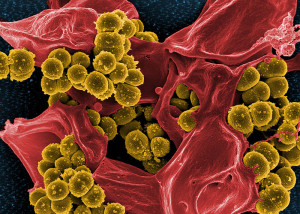 This post will discuss the elaborate communication needed to regulate the many details of building, maintaining and dismantling a functioning biofilm. Somehow, individual cells understand what is needed in the large structure outside of their own cell and local environment. They respond to the needs of the larger structures by producing particular proteins and polysaccharide molecules at different locations. Bacteria work together to build a biofilm civilization with attention to great detail and elaborate regulation and signaling. Where is the direction for all of this?
This post will discuss the elaborate communication needed to regulate the many details of building, maintaining and dismantling a functioning biofilm. Somehow, individual cells understand what is needed in the large structure outside of their own cell and local environment. They respond to the needs of the larger structures by producing particular proteins and polysaccharide molecules at different locations. Bacteria work together to build a biofilm civilization with attention to great detail and elaborate regulation and signaling. Where is the direction for all of this?
Vibrio Cholera Biofilms
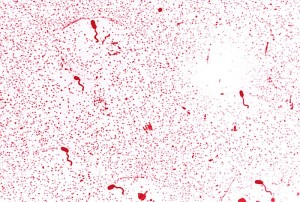 Many different bacteria build biofilms. Vibrio cholera forms a biofilm that has been studied the most over the past twenty years. Much of the detail in this post is related to studies of V. cholera. Cholera creates biofilms both in the water and in the human intestines. Some strains of cholera can cause a potentially fatal disease with diarrhea and severe loss of water. Four million cases occur each year with 100,000 deaths. A toxin produced by the bacteria, especially while they are in the biofilm, causes the severe illness in humans. It is the biofilms that allow them to be so successful. Biofilms protect them from protozoa and viruses. It, also, helps storing food.
Many different bacteria build biofilms. Vibrio cholera forms a biofilm that has been studied the most over the past twenty years. Much of the detail in this post is related to studies of V. cholera. Cholera creates biofilms both in the water and in the human intestines. Some strains of cholera can cause a potentially fatal disease with diarrhea and severe loss of water. Four million cases occur each year with 100,000 deaths. A toxin produced by the bacteria, especially while they are in the biofilm, causes the severe illness in humans. It is the biofilms that allow them to be so successful. Biofilms protect them from protozoa and viruses. It, also, helps storing food.
Cholera likes to build biofilms on various passing plankton cells and with a particular material (chitin) from the structural skeleton of specific types of plankton. There are a variety of different kinds of plankton that are utilized. Chitin can become the major food for the biofilm society. Chitin is N-acetyl-D-glucosamine and includes carbon, nitrogen and other forms of energy. Bacteria, also, use secreted DNA in the biofilms. They are able to pick up DNA and either break it down for parts, or use it for genetic recombination. This type of DNA used for communication is called eDNA. It is transported across the membrane and an elaborate metabolic cycle regulates its use. It can be broken down into nucleotides if there is not enough material for the new DNA made while reproducing. The genes in the DNA can become part of the genetic repertoire of the bacteria. Through this process genes can be transmitted among the biofilm members.
 When plankton blooms, there are more biofilms and more disease outbreaks. Plankton comes in all sizes and types. It can be tiny made from viruses and bacteria; medium sized from diatoms; and huge from jellyfish. The two major types are phytoplankton and zooplankton. Phytoplankton (plant) can be algae living near the water surface and able to use photosynthesis (diatoms, cyanobacteria). Zooplankton (animal) can be made from small crustaceans and other animals. These usually eat other plankton and include eggs and larvae from fish.
When plankton blooms, there are more biofilms and more disease outbreaks. Plankton comes in all sizes and types. It can be tiny made from viruses and bacteria; medium sized from diatoms; and huge from jellyfish. The two major types are phytoplankton and zooplankton. Phytoplankton (plant) can be algae living near the water surface and able to use photosynthesis (diatoms, cyanobacteria). Zooplankton (animal) can be made from small crustaceans and other animals. These usually eat other plankton and include eggs and larvae from fish.
 Cholera can live in a quiet state where they are circular and then change to the active rod shape. In the water it is very mobile. In biofilms, it exists on many different surfaces, including zooplankton and phytoplankton and their sediments. Active cells signal to other quiet cells to change back into the active form. In the biofilm, cells can become quiet as a way to decrease the need for food when it is scarce. Biofilms are more resistant to human immune defenses. The cholera polysaccharide (VPS) is increased during human infection.
Cholera can live in a quiet state where they are circular and then change to the active rod shape. In the water it is very mobile. In biofilms, it exists on many different surfaces, including zooplankton and phytoplankton and their sediments. Active cells signal to other quiet cells to change back into the active form. In the biofilm, cells can become quiet as a way to decrease the need for food when it is scarce. Biofilms are more resistant to human immune defenses. The cholera polysaccharide (VPS) is increased during human infection.
Attachment to A Surface
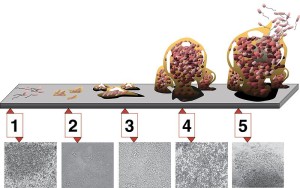
The bacteria first have to find a proper place to build a biofilm. Pili (also called fimbria or flagella) first make contact with the surface where the biofilm will be built. Then the cells secrete substances, such as polysaccharides and proteins. Some of the bacteria lose their flagella or pili during the process. Later, they produce other types of pili that help manufacture the toxin that causes the severe disease in humans.
To identify the spot to start the biofilm, bacteria travel over a surface in a particular way studying the terrain. There are several different types of movement used. One, called “roaming,” is zigzagging and curving, such that it covers most of the area for observation.
Another type of mobile behavior, called “orbiting,” is where they hover over specific areas moving in a circular orbit. Water movement near a surface makes them move in circular directions and pulls them down toward the surface. They use their one flagellum or pili sweeping over the surface, which has a drag force making the cells move in a curved clockwise path.
Both types of movement are clockwise and away from the axis of the cell; it is a slanting direction that is neither perpendicular nor parallel. This movement is dependent upon specific pili.
Special Attachment Pili
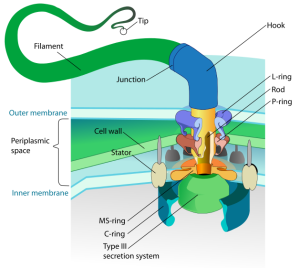 The appendages called pili, (also, fimbria or when larger flagella) are very complex and have many different roles. One obvious role is for movement. Another is for the very particular attachment process. These appendages are, also, used to attach to animal cells and many inorganic surfaces. One special type of pili used in biofilms is called type IV, which is very important for biofilms by being adept at attaching to both other bacterial cells and to surfaces. After touching, the pili then contracts pulling the cells together. This type IV pili uses a jerky movement as opposed to flagella, which provides for excellent swimming motion.
The appendages called pili, (also, fimbria or when larger flagella) are very complex and have many different roles. One obvious role is for movement. Another is for the very particular attachment process. These appendages are, also, used to attach to animal cells and many inorganic surfaces. One special type of pili used in biofilms is called type IV, which is very important for biofilms by being adept at attaching to both other bacterial cells and to surfaces. After touching, the pili then contracts pulling the cells together. This type IV pili uses a jerky movement as opposed to flagella, which provides for excellent swimming motion.
When starting a biofilm, flagella touch the surface occasionally with friction. This process evaluates the surface by the type of friction produced. Some surfaces have a stronger reaction to the special pili. When roaming, the surface contact is weak, and during orbiting it is stronger.
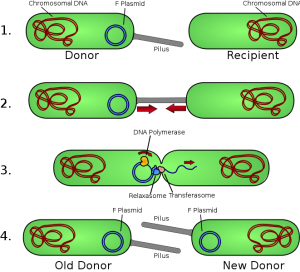
Orbiting cells stop several times and then eventually attach to the surface by the specialized pili. The special type of pili is critical to have the strength to stop the cell’s movement and finally attach.
Other microbes have a different type of movement, pili and attachment. For example, the pseudomonas moves vertically, and then moves as if walking along the surface multiple times attaching temporarily until finally attaching permanently in a horizontal position. Each step in the process uses energy and forms a type of “twitch”. As soon as there is attachment, the microbe secretes polysaccharides and extra cellular DNA that starts the cell colony when it attaches.
Cholera uses a single special pili and the particular movement to scan the surface before attaching. The pili appear to have a mechanoreceptor that recognizes the surface. After attachment the lack of a pili is one signal to produce more of the matrix material.
Matrix Components
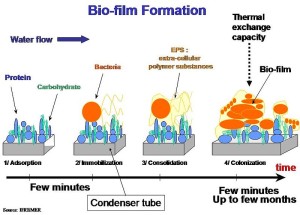
Once attached, cells produce more of the extra cellular matrix material that builds a three dimensional structure. This material is made of polysaccharides, phospholipids, proteins and nucleic acids. Cholera biofilms have more sugar and E. coli more protein.
Most of the matrix is formed by polysaccharides that help make the 3D structure. Different kinds of polysaccharides are used for different purposes. One type is secreted immediately after the attachment and continues throughout the building phase. Several other different types create complex structures attached to other molecules. Some of the material is attached to the cell and some not.
Many gene networks make varied materials for specific purposes. Two clusters of genes make different types of polysaccharides for the matrix, 12 genes for one and 6 for another. Some make enzymes that produce precursors of sugars for nucleotides. Another group of genes creates several different enzymes that build the polysaccharides. Several are related to special types of biofilms at the water-air interface. These genes operate as a network called V cholera biofilm matrix cluster. These, also, make five critical proteins that have many functions.
 There are three matrix proteins that have different properties and are secreted at different times. One helps connect cells to each other and to the larger structure. These are similar to cell adhesion molecules with fibronectin folds that make grooves where large and small molecules such as glycoproteins in the cell’s membrane can bind forming a scaffold made of monosaccharides and lipopolysaccarhides. In biofilms that float at the air-water interface, these proteins make the biofilm flexible.
There are three matrix proteins that have different properties and are secreted at different times. One helps connect cells to each other and to the larger structure. These are similar to cell adhesion molecules with fibronectin folds that make grooves where large and small molecules such as glycoproteins in the cell’s membrane can bind forming a scaffold made of monosaccharides and lipopolysaccarhides. In biofilms that float at the air-water interface, these proteins make the biofilm flexible.
Several other proteins are made that recognize and then bind particular materials to build the 3D structure. The first cells that attach to the surface continue to make these proteins. These molecules are hydrophobic allowing the structure to be built in the water.
Another special protein binds to specific new sites on the surface as more cells are produced for the community that is being built. It forms envelops for cells that grow as the cells divide. The 3D biofilm becomes a collection of discrete clusters organized by the multiple different enzymes and structural proteins.
 Large proteins are secreted from the cells by a special mechanism called the type II secretion system. This elaborate complex of multiple interlocking proteins transports large proteins from just below the membrane to the outside of the membrane. It secretes most of the critical proteins needed to build the 3D structures. Polysaccharides are not excreted this way. Studies show that without this particular secretion machinery, biofilms are not built.
Large proteins are secreted from the cells by a special mechanism called the type II secretion system. This elaborate complex of multiple interlocking proteins transports large proteins from just below the membrane to the outside of the membrane. It secretes most of the critical proteins needed to build the 3D structures. Polysaccharides are not excreted this way. Studies show that without this particular secretion machinery, biofilms are not built.
Another very complex structure, critical to building biofilms, are outer membrane vesicles (OMVs). These unique structures perform many complex functions for bacteria. They help secrete molecules that are insoluble and difficult to transport any other way. They transport enzymes to very special places in a very concentrated form. They help gather nutrients in response to stress. They help create human pathology.
OMVs bulge out from the membrane in special places. They send special cargoes to build biofilms including proteins bound to membranes, signals for community quorum signaling and eDNA. All of this material is secreted in a very concentrated way and is tagged to be transported to very particular sites. It is similar to the tagging of vesicles in large human cells that bring special material to very particular addresses in specific locations. Vesicles in neurons are transported along the microtubules long distances marked in this way for particular destinations.
The OMV connects with several of the previously mentioned proteins and a special protein on the membrane. These stop molecules that would hurt the bacteria increasing their resistance.
How does an individual cells know that it is about to build a large three dimensional structure and start making all of these different proteins?
Biofilm Dispersal
 After the establishment of the biofilm structure and its maintenance, the colony decides it is time to move on by dispersing the biofilm community. Some of the cells leave and move to other areas that have more food. Other proteins help in this process as does eDNA with enzymes. eDNA is secreted by the bacteria that regulate nutrients and binds components together in a scaffold. It helps as a structural material—an adhesion device during the breakdown of the biofilm.
After the establishment of the biofilm structure and its maintenance, the colony decides it is time to move on by dispersing the biofilm community. Some of the cells leave and move to other areas that have more food. Other proteins help in this process as does eDNA with enzymes. eDNA is secreted by the bacteria that regulate nutrients and binds components together in a scaffold. It helps as a structural material—an adhesion device during the breakdown of the biofilm.
Special enzymes start taking apart eDNA which helps to release cells from the biofilm. There are other enzymes that break up the polysaccharides.
Regulation of Biofilm Function
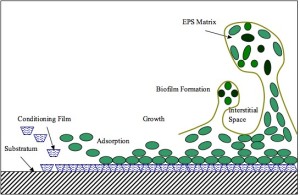
With a very complex architecture, the biofilm is a highly regulated civilization of many cells performing many tasks. Regulation occurs through multiple signaling cascades and feedback loops from many cells. It is remarkable that cells in one area can respond to the needs of the larger biofilm. There are large numbers of regulatory molecules that trigger genetic networks for each phase of the biofilm. How these individual cells know that they are building a large 3D structure vastly bigger than themselves is unknown.
There are multiple activators and repressors that regulate DNA especially for the biofilm, as well as molecular signals and special factors. More than three different discrete and interacting elaborate cascades inside cells regulate building the matrix with information from a series of receptors. There are quorum-sensing responses when the entire colony is summoned to work together on the project. The biofilm life style and the various regulatory processes use a lot of extra energy. Regulation is very dynamic and changeable responding to many factors in the environment while building a safe and protected civilization. The group regulation allows individual bacteria to respond to many of the effects of environmental changes.
 Another system is the major regulator of biofilms consisting of two different components. One is a receiver connected to multiple enzymes that can be activated in different directions. The second is a system of triggering DNA networks through binding molecules of various types including phosphorylation. These change production of various proteins by direct gene alterations. It regulates both the matrix structure and toxins created to attack a host. Each step has a variety of different feedback loops.
Another system is the major regulator of biofilms consisting of two different components. One is a receiver connected to multiple enzymes that can be activated in different directions. The second is a system of triggering DNA networks through binding molecules of various types including phosphorylation. These change production of various proteins by direct gene alterations. It regulates both the matrix structure and toxins created to attack a host. Each step has a variety of different feedback loops.
There is another system of regulation as well—the positive regulator. This regulates responses. Both of these complex regulatory systems interact constantly. Each can modify the other’s actions. Together they target all of the genes involved.
A third regulatory system is the negative regulator. This system provides checks and balances and will destroy the biofilm if unchecked. This system provides a balance for not overbuilding and is more activated when the biofilm is being dismantled at the end of its life. This system uses a variety of small RNAs to regulate various gene regions. These RNAs cause the biofilm to be built or torn down.
 There are other regulator systems that are involved in the quorum sensing communication with all of the cells in the colony. These work through kinases and small RNAs. A critical protein functions in between multiple different systems. One critical molecule is similar to a histone in the nucleus affecting the shape of the chromatin. Another specific nucleotide serves as a critical messenger in the regulatory cascades (c-di-GMP). It works with ribo-switches. These, also, regulate the flagella and swimming velocity.
There are other regulator systems that are involved in the quorum sensing communication with all of the cells in the colony. These work through kinases and small RNAs. A critical protein functions in between multiple different systems. One critical molecule is similar to a histone in the nucleus affecting the shape of the chromatin. Another specific nucleotide serves as a critical messenger in the regulatory cascades (c-di-GMP). It works with ribo-switches. These, also, regulate the flagella and swimming velocity.
Multiple enzymes are regulated in a vast array of different mechanisms for different results. Each can trigger dozens of genes. Different levels of nutrients produce various signals, cascades and responses.
Other critical factors influence the biofilm, such as when bacteria are stressed by lack of nutrients. Entirely different signals alter anabolic and catabolic processes. Sudden synthesis of guanosine tetraphosphate and pentaphosphate stimulate these metabolic cycles. Without the ability to use these two molecules, biofilms cannot be produced.
 Yet another level of small RNAs regulate building and repressing the biofilm. These small RNAs have their own pathways that bypass the major regulatory pathways and are another level of complex regulation of building the matrix.
Yet another level of small RNAs regulate building and repressing the biofilm. These small RNAs have their own pathways that bypass the major regulatory pathways and are another level of complex regulation of building the matrix.
There are other signals related to environmental signals. Specific sugars mannose and glucose increase biofilm formation through a very ancient pathway. When there are no sugars present, then the formation is repressed. Changes in the amount of salt and the density of molecules in the water affect the formation of biofilms through cascades that trigger genetic networks. Specific transcriptional factors respond to the level of salt and solute density. When there is low phosphate another regulatory system stops formation of the biofilm. Calcium and indole levels, also, affect the biofilm. Another regulator is bile that stimulates biofilm formation in the human gut.
Bacteria Work Together to Build a Biofilm Civilization
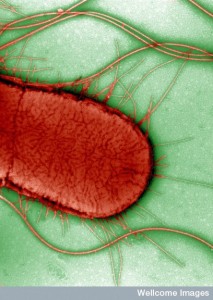 Bacteria, remarkably, can communicate well enough to perform complex group activity. Perhaps, the most elaborate is building a biofilm civilization. This 3D structure becomes a safe place for the community. It allows them to build pathological powerful toxins to stimulate disease in the host. It protects against predators, environmental stress and nutrient loss.
Bacteria, remarkably, can communicate well enough to perform complex group activity. Perhaps, the most elaborate is building a biofilm civilization. This 3D structure becomes a safe place for the community. It allows them to build pathological powerful toxins to stimulate disease in the host. It protects against predators, environmental stress and nutrient loss.
Individual cells somehow know how to secrete the materials needed to form the extracellular matrix. Many different materials are used involving many distinct metabolic processes. Genetic networks are stimulated for each type of function. Cells produce several unique organelles that are needed to build the biofilm. One is the unique type of pili or flagella to make contact with the surface. The second are specific secretion mechanisms to provide materials for the matrix between and around the cells. And the third is a special outer membrane vesicle that delivers exact cargo to specific locations in the biofilm.
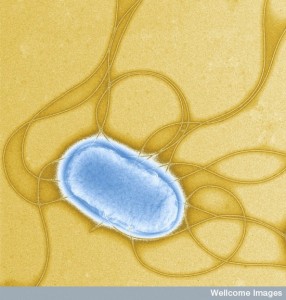 Biofilms require many polysaccharides and proteins to build the matrix and special molecules to attach them to various surfaces. Specific enzymes are needed to build the polysaccharides and specific genetic networks trigger the various proteins needed. These multiple proteins form the architecture and the specific different regions require different kinds of scaffolding and structures. Multiple genetic regulators are controlled complex circuits and cascades with interlocking effects with a balance of stimulation and suppression, building up structures and taking them down. The signals between the individual cells with quorum sensing are a critical part of the communication.
Biofilms require many polysaccharides and proteins to build the matrix and special molecules to attach them to various surfaces. Specific enzymes are needed to build the polysaccharides and specific genetic networks trigger the various proteins needed. These multiple proteins form the architecture and the specific different regions require different kinds of scaffolding and structures. Multiple genetic regulators are controlled complex circuits and cascades with interlocking effects with a balance of stimulation and suppression, building up structures and taking them down. The signals between the individual cells with quorum sensing are a critical part of the communication.
The biofilm is highly regulated by many different pathways, loops and genetic networks. How do these individual cells understand the overall structure enough to build a large 3D biofilm?